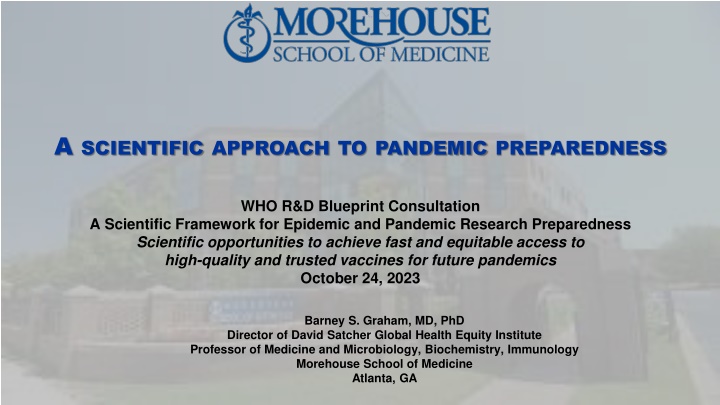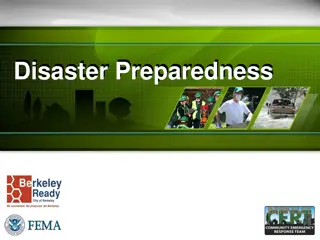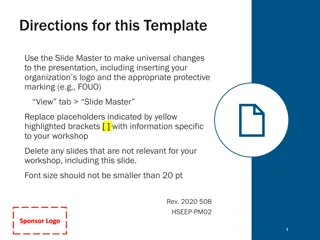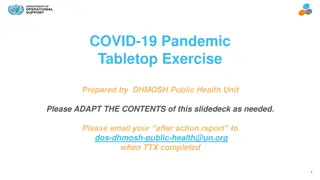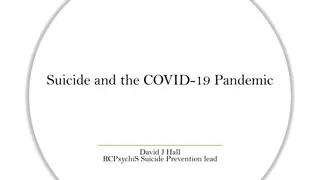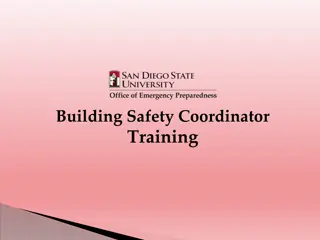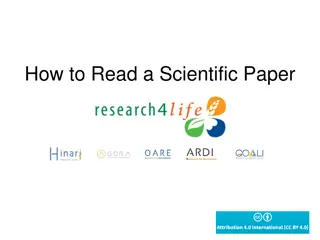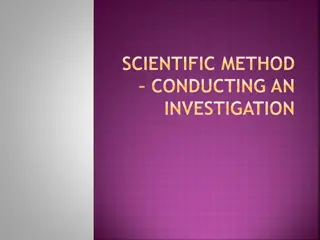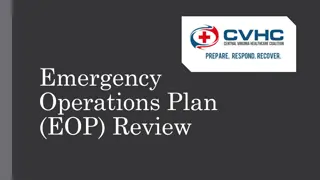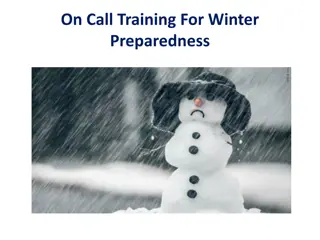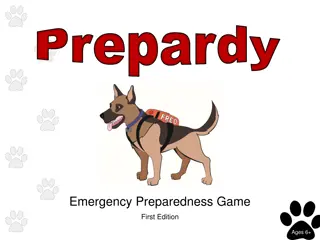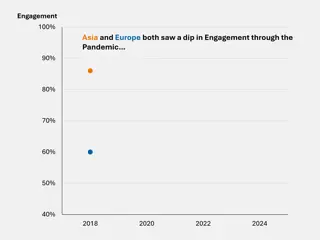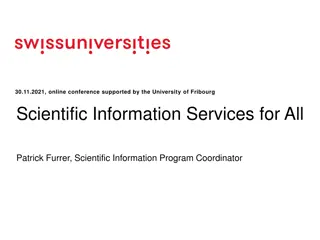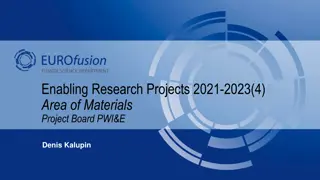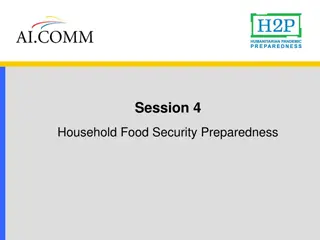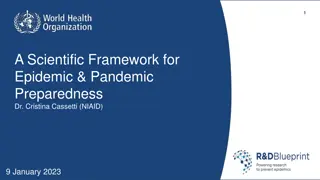A Scientific Approach to Pandemic Preparedness
Barney S. Graham, MD, PhD, outlines a scientific framework for epidemic and pandemic research preparedness to achieve fast and equitable access to high-quality vaccines for future pandemics. The discussion covers new human viral pathogens, 21st-century viral threats, viral taxonomy, and a prototype pathogen approach, emphasizing the importance of global governance and collaboration with industry and regulatory authorities.
Download Presentation

Please find below an Image/Link to download the presentation.
The content on the website is provided AS IS for your information and personal use only. It may not be sold, licensed, or shared on other websites without obtaining consent from the author.If you encounter any issues during the download, it is possible that the publisher has removed the file from their server.
You are allowed to download the files provided on this website for personal or commercial use, subject to the condition that they are used lawfully. All files are the property of their respective owners.
The content on the website is provided AS IS for your information and personal use only. It may not be sold, licensed, or shared on other websites without obtaining consent from the author.
E N D
Presentation Transcript
A SCIENTIFICAPPROACHTOPANDEMICPREPAREDNESS WHO R&D Blueprint Consultation A Scientific Framework for Epidemic and Pandemic Research Preparedness Scientific opportunities to achieve fast and equitable access to high-quality and trusted vaccines for future pandemics October 24, 2023 Barney S. Graham, MD, PhD Director of David Satcher Global Health Equity Institute Professor of Medicine and Microbiology, Biochemistry, Immunology Morehouse School of Medicine Atlanta, GA
Disclosures Vaccine Inventor Coronaviruses Respiratory syncytial virus Influenza virus Nipah and other paramyxoviruses Zika Monoclonal Antibody Inventor Ebola SARS-CoV-2 and other coronaviruses Scientific Advisory Boards Icosavax Vaccine Company, Inc. Third Rock Ventures, Inc. Foundry Consultant GSK Pfizer Janssen Sanofi Merck AstroZeneca Exevir
New Human Viral Pathogens in the 20th Century New species linear New families plateauing Woolhouse MEJ et al Proc R Soc B 2008; 275:2111
21st Century Viral* Threats and Needs Outbreaks SARS-CoV-1 H5N1 influenza H1N1 influenza MERS Chikungunya Ebola Marburg Zika Nipah EV-D68 SARS-CoV-2 Monkeypox Unsolved Problems Could be better Influenza Mumps Yellow Fever Filoviruses HIV HCV Dengue and other flaviviruses Alphaviruses Norovirus and other nonenveloped viruses Bunyaviruses CMV and other herpesviruses Rapid response approach for Paramyxoviruses Polyomaviruses Other emerging infections *Not to mention malaria, Tb, and all the virulent or untreatable bacteria, fungi, and parasites
Viral Taxonomy 2023 6 realms 10 kingdoms 17 phyla 2 subphyla 40 classes 72 orders 8 suborders 264 families 182 subfamilies 2818 genera 84 subgenera 11273 species ~150 viruses from 26 families recognized as human pathogens with potential for person-to-person spread
Prototype Pathogen Approach for Pandemic Preparedness Prototype Pathogen Approach for Pandemic Preparedness Pathogen biology, product development, preclinical and clinical evaluation supported by global governance and pre-established relationships with industry, regulatory authorities, and public health systems ~150 viruses from 26 families known to infect humans with some potential for increased human-to-human transmission and virulence Develop vaccines for ~30 prototype viruses through phase 1 Develop vaccine candidates (& reagents) for other ~120 through animal testing Graham & Sullivan. Nature Immunology 2018
Pandemic Preparedness Know what s coming Virus discovery Surveillance humans, animals, and vectors Know what to do Virus characteristics including pathogenesis Basis of immunity identify antigen target Antigen design and delivery Know how to make biomedical countermeasures Reagents including rapid mAb identification and production Diagnostics Antivirals preventive and therapeutic Vaccines Animal models Know how to deploy interventions rapidly on a global scale Maintenance and geographic distribution of manufacturing and clinical facilities scale-up capacity Organization of governments, agencies, industry, academia, and nonprofit organizations Coordination of regulatory processes and requirements Communication with the public
Global COVID-19 Vaccine Landscape 199 Vaccine Candidates in Pre-clinical Evaluation 178 Vaccine Candidates in Clinical Evaluation Nanoparticle display of structurally defined proteins Nucleic acid Whole-inactivated virus Live-attenuated virus Recombinant Vectors Recombinant or chimeric viruses Virus-like particles Recombinant proteins or subdomains Peptides Source: WHO 14 February 2023 Slide 8
Finding Generalizable Approaches and Breakthroughs Finding Generalizable Approaches and Breakthroughs Successes Structure-based antigen design Self-assembling nanoparticle display Nucleic acid, vector, or protein delivery Single-cell analysis Targeting antibody lineages Barriers to Pandemic Preparedness Antigenic diversity Immunodominance Durable responses Mucosal immunity Immune evasion Potential for enhanced disease Glycan shield Integration and latency
Structure of Prefusion RSV F Glycoprotein Structure of Prefusion RSV F Glycoprotein Prefusion Postfusion
Targeting right antigenic site matters Targeting right antigenic site matters Week 0 Week 1 Pre-F Dual DS-Cav1 (Pre-F) Post-F MEDI7510 (Post-F) Pre-F Post-F Emily Phung, Lauren Chang
Finding Generalizable Approaches Finding Generalizable Approaches Successes Virus-like particles Whole-inactivated Live-attenuated Barriers to pandemic preparedness Multiple serotypes Structure and antigen definition Mucosal immunity
Finding Generalizable Approaches Finding Generalizable Approaches Successes Replication-defective virus Live-attenuated Protein subunit Barriers to pandemic preparedness Structure and antigen definition Mucosal immunity Integration and latency
Finding Generalizable Approaches Finding Generalizable Approaches Successes Live-attenuated Virus-like particle Barriers to pandemic preparedness Antigen structure Antibody-dependent enhancement
Pandemic Response Early detection Sequence availability Epidemiology Point of care diagnostics Maintenance of public health infrastructure and reporting Rapid production of fit-for-purpose products Use strain-matched antigens for vaccines mAbs for diagnostics and therapy Antivirals Agent-specific animal models Deploy Will require prior planning and agreements between governments, between agencies within governments, between governments and non-government organizations with methods of coordination and communication Public-private agreements between nonprofits, philanthropists, academia, and industry
Take Home Messages We have the science and technology to solve most future problems but are lacking in the areas of policy and practice Need consensus on global coordination, communication, and governance Equitable distribution of basic science, translational science and manufacturing is critical to solve local problems before they become global Investment in basic research Surveillance needs support for prospective cohorts and sequencing facilities Distributive manufacturing is feasible but needs small market business models Pandemic response will usually require strain-matched products Prior generalizable solutions Emphasis on speed and global coverage
